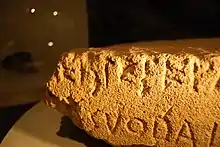Lapis Satricanus
The Lapis Satricanus ("Stone of Satricum"), is a yellow stone found in the ruins of the ancient town of Satricum, near Borgo Montello (41°31′N 12°47′E), a village of southern Lazio, dated late 6th to early 5th centuries BC.[1] It was found in 1977 during excavations by C.M. Stibbe.[2][1]

Content
It reads:
- (?)IEI STETERAI POPLIOSIO VALESIOSIO
- SVODALES MAMARTEI[3]
("The (?) dedicated this, as companions of Publius Valerius, to Mars")
Points of interest
Old Latin origins
This inscription has attracted attention for several reasons. Its language has been identified as Old Latin or a closely related dialect.[4] It is important for comparative Indo-European grammar, as it is the only Latin inscription to show the ending -osio for the genitive singular of the thematic noun declension. Latin later has -ī as the ending for this case, but by comparison with Sanskrit, Mycenaean and Homeric Greek and other languages, it becomes clear that -osio is a far earlier form.[5]
Usage of word suodales

Another point of interest is the presence of the word suodales (Classical Latin sodales). In historic times, this word referred to a member of a sodalitas, a religious fraternity or brotherhood who met for ritual meals or as a burial organization. "Since the suod- element in suodales is cognate with the English word 'swear'", writes Gary Forsythe, "the term suggests that some kind of oath was taken, binding the members of the group together in a common purpose." Forsythe uses this and that this was a dedication to Mars to suggest this indicates the existence of an armed group of sworn followers, similar to "the war bands led by Homeric heroes, the warlike aristocratic companions of the Macedonian kings during the classical period, and the war bands surrounding the Celtic and Germanic chieftains described by Caesar and Tacitus".[6] Forsythe notes this puts a new light on the account of the Battle of the Cremera, an event where the entire gens Fabia fought as a group the armed men of the rival town of Veii only to be tragically defeated.[7]
Inscribed names
A third point of interest to historians and archaeologists of early Latium is the name preserved on the inscription.[8] The archaic name of Poplios Valesios is rendered in Classical Latin as "Publius Valerius". That has led to speculation that the inscription refers to Publius Valerius Publicola, the patrician ally of Lucius Junius Brutus who dominates the list of early consuls recorded by the Fasti Capitolini and is credited, in traditional accounts, as one of the primary founders of the Roman Republic. Positive identification is at least somewhat problematic because the town of Satricum was not part of Roman territory when Publius Valerius was consul. However, the "lapis" itself may not have been dedicated in Satricum in the first place since it was found as part of a collection of recycled material used in the construction of a temple in the town, and it could well have been imported from elsewhere.
References
- C. M. Stibbe (1980). Lapis Satricanus. Ministerie van Cultuur, Recreatie en Maatschappelijk Werk. ISBN 978-90-12-02951-3.
- see the Dutch lemma on C.M. Stibbe.
- CIL I2 2832a
- Philip Baldi (January 2002). The Foundations of Latin. Walter de Gruyter. pp. 204–. ISBN 978-3-11-017208-9.
- Robert Stephen Paul Beekes (2011). Comparative Indo-European Linguistics: An Introduction. John Benjamins Publishing. ISBN 90-272-1185-X.
- Forsythe, A Critical History of Early Rome (Berkeley: University of California, 2005), p. 199
- Forsythe, A Critical History, p. 198
- Jeremy Armstrong (8 April 2016). War and Society in Early Rome. Cambridge University Press. pp. 144–. ISBN 978-1-107-09357-7.